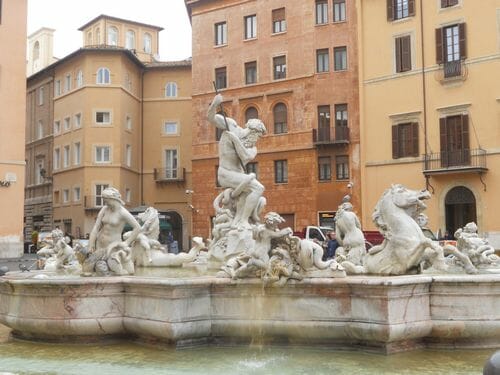When it comes to visit Rome, the underground Rome should not be missed. We selected two very interesting Rome attractions: Stadio di Domiziano & Piazza Navona.
Piazza Navona is dressed to the nines every day to show the best to every tourist that passes by. It is impossible not to be overwhelmed by the grandeur of this open space at the center of palaces which like colorful wings of brick envelope it making this one of the most interesting Rome attractions. Its amplitude leaves us vaguely to imagine what this place actually has represented over time.

What immediately catches the eye is the main fountain and its obelisk placed at the center of the square: the “Fountain of the Rivers ” by Bernini . [Photo 3] In it are represented the four main rivers of the world as known at the time, the four corners of the earth: the Nile, Ganges, Danube and Rio della Plata. Creating a frame, are the two other fountains: the Fountain of the Moor , to the north side and the Fountain of Neptune , on the south side.

The church of St. Agnes and then next to it the splendid palace Pamphili, which now houses the Brazilian Embassy , make the style of this part of Rome truly spectacular.
The viewer’s gaze is so fascinated by the Baroque atmosphere that is shown to us, not knowing perhaps that the true face of this square is buried, below the road surface ( like maybe almost all the wealth of the Italian capital .) And to find out what this place really is we must not stop here.
We continue to the northern part of the square and on the right along via Lorenesi .
Here, in Largo Febo, we cross via the Tor Sanguigna and on the right is the entrance we are looking for. Behind a glass door we can see some relics of Domitian Stadium. This is what this most amazing of Rome attractions, the Piazza Navona was originally.

Domitian, the last emperor of the Flavian dynasty, established the feast dedicated to Jupiter in the year 86AD. The celebration included music, gymnastics and equestrian competitions. To give an adequate place at these shows he built this stage. The affordable cost of the ticket allows us to enjoy total freedom in a small glimpse of Roman architecture through the remnants of that time. And in fact this is the first known example of a stadium outside of the Greek world at that time. A series of plaques with the explanations of the site guides us to discover its fascinating history.

The stadium Domitian has a circus form with the long sides parallel, one curved side , the other slightly oblique and measuring about 275 meters by 106. We cross those spaces that were once the sidelines and observe what remains of one of the staircases, placed once at regular interval every five arches, which led to the sidelines . [12 PHOTOS ]Here, in order of class, each viewer could enjoy the games of the era.A little further ahead a video of about four minutes shows a reconstruction of Piazza Navona in the time of Domitian. During the games it had an exceptional capacity of about 30,000 people.

Now as you go back again to the surface to the center of the square, you will see the buildings with different eyes as you notice that the ancient stadium below is reflected in the design. Then you will really appreciate the glory of Piazza Navona, truly one of the finest Rome attractions.

